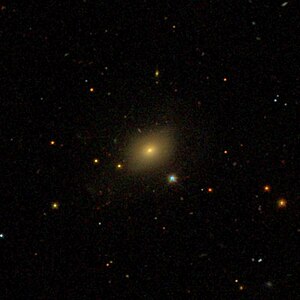NGC 1149
| Galaxy NGC 1149 |
|
|---|---|

|
|
| SDSS recording | |
| AladinLite | |
| Constellation | whale |
|
Position equinox : J2000.0 , epoch : J2000.0 |
|
| Right ascension | 02 h 57 m 23.9 s |
| declination | -00 ° 18 ′ 34 ″ |
| Appearance | |
| Morphological type | S0- |
| Brightness (visual) | 14.2 mag |
| Brightness (B-band) | 15.2 mag |
| Angular expansion | 0.6 ′ × 0.5 ′ |
| Position angle | 130 ° |
| Surface brightness | 13.0 mag / arcmin² |
| Physical data | |
| Redshift | 0.029141 ± 0.000107 |
| Radial velocity | 8736 ± 32 km / s |
|
Stroke distance v rad / H 0 |
(390 ± 27) · 10 6 ly (119.6 ± 8.4) Mpc |
| history | |
| discovery | Edouard Stephan |
| Discovery date | December 2, 1880 |
| Catalog names | |
| NGC 1149 • PGC 11170 • CGCG 389-054 • MCG + 00-08-058 • 2MASX J02572383-0018340 • | |
NGC 1149 is a lenticular galaxy of the Hubble type E-S0 in the constellation Whale in the southern sky . It is an estimated 390 million light years from the Milky Way .
The object was discovered on December 2, 1880 by the French astronomer Edouard Stephan .
